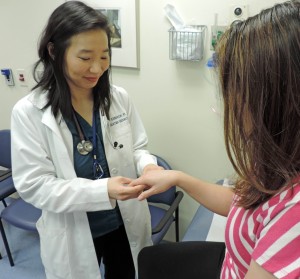
Distinct changes to the immune system precede the onset of rheumatoid arthritis (RA), according to a new study funded in part by the NIH’s National Institute of Arthritis and Musculoskeletal and Skin Diseases (NIAMS). The data revealed elevated levels of an antibody-producing cell type found in mucosal areas such as the mouth, lungs and intestinal tract in people at high risk of developing the disease. The findings, which appeared in Arthritis and Rheumatology, represent a step toward understanding how RA begins and may lead to novel strategies for halting its progression.
RA is a chronic disease in which the immune system mistakenly attacks the joints, creating inflammation and pain. If unchecked, this autoimmune disorder can erode the cartilage and bone in joints, resulting in reduced mobility and impaired quality of life. There is no cure for RA, but medicines that dampen inflammation help reduce joint damage and ease the discomfort. Joint replacement surgery is also an option in severe cases.
"Current therapies for RA work by reducing inflammation in people with active disease," said V. Michael Holers, M.D., of the University of Colorado, Denver, and senior author of the study. "Our approach is focused on taking a few steps back and studying the molecular mechanisms that trigger RA so that we can find ways to treat it before symptoms occur and any damage is done."
Over the past decade, research has shown that autoantibodies—antibodies that attack the body’s own proteins—appear several years before any outward signs of the disease. However, the exact nature of these autoantibodies has remained unclear. A better understanding of their structure and the specific proteins that they target could reveal important clues to how RA starts.
To advance this effort, Dr. Holers’s team, in collaboration with William H. Robinson, M.D., Ph.D., of Stanford University, focused on antibody-producing B cells called plasmablasts. Prior studies had shown that levels of these cells correlate with disease activity in people with RA. Earlier work also showed that plasmablasts in RA patients produce RA-specific autoantibodies called anti-citrullinated protein antibodies and rheumatoid factors.
In the current study, the investigators compared plasmablast levels in three groups of individuals: people at high risk of developing RA, those with early-stage RA and healthy controls. People were placed in the high-risk group based on having a first-degree relative with RA or other risk factors, and having begun producing RA-specific autoantibodies in a pattern that predicts a high likelihood of soon developing clinically-apparent disease.
The analysis revealed significant differences among the groups. The at-risk group had a higher proportion of plasmablasts that produce IgA antibodies, a subtype that dominates at mucosal surfaces of the body—39 percent, compared to 1 and 9 percent for control and early RA individuals, respectively.
The researchers also observed differences among the groups in the proportion of plasmablasts that produce IgG antibodies, a subtype that circulates in the bloodstream. People in the at-risk group had 37 percent IgG plasmablasts, compared to 87 percent in controls and 71 percent in the early RA group.
These results suggested that a mucosal immune response could set the stage for the development of systemic autoimmunity that characterizes RA. This idea is consistent with the strong association between RA and smoking and emerging data linking inflammation of the mouth, lungs or intestinal tract to the disease.
"We now know that the autoimmunity that characterizes RA begins years before clinical signs and symptoms are apparent," said Dr. Holers. "By studying individuals in this period, we’ve discovered that RA—a disease of the joints—actually appears to begin through a process linked to mucosal inflammation."
The team went on to decipher the gene sequences of some of the antibodies produced by people in the high-risk group. In future work, the researchers aim to use this information to identify the specific proteins that these antibodies target. This knowledge may eventually enable scientists to find ways to tamp down the immune system’s attack on these proteins, thereby preventing progression toward active disease.
This work was supported by the NIH’s NIAMS (T32-AR007534) and National Institute of Allergy and Infectious Diseases (U01-AI101981).
# # #
Elevated IgA Plasmablast Levels in Subjects at Risk of Developing Rheumatoid Arthritis. Kinslow JD, Blum LK, Deane KD, Demoruelle MK, Okamoto Y, Parish MC, Kongpachith S, Lahey LJ, Norris JM, Robinson WH, Holers VM. Arthritis Rheumatol. 2016 Oct; 68(10):2372-83. doi: 10.1002/art.39771. PMID: 27273876
